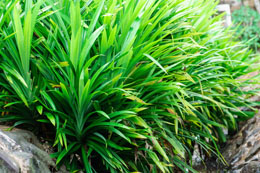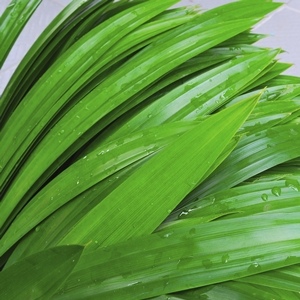A widely-cultivated herbaceous tropical plant, the pandan leaves are used in Southeast Asian cooking as a flavoring. Here is a Buzzle post that gives you in-depth information about the aromatic leaves.

Pandan leaves come from the plant
Pandanus amaryllifolius, which is also called pandan plant. The plant is native to Asia and tropical parts of Australia. Most predominantly used the Southeast Asian cooking, this upright green plant has fan-shaped sprays like structure of leaves that are narrow and blade-like. The leaves are attached to the woody aerial roots of the plant. It is known to be sterile and is often propagated by cutting. The leaves are dark green in color, with strong nutty aroma.
The leaves are used to provide a unique flavor and aroma to many Thai desserts and drinks. While preparing savory foods, the leaves are used to wrap the food items in, such as chicken. Also, the leaves are used to make a paste that are mostly included in cakes and other desserts.
Brief Information

The main purpose to cultivate this plant is to gain the leaves that bless various culinary items in most of the Asian cooking. Used in both forms―fresh and wilted―the leaves are also available in frozen form in various parts of the world, outside Asia, as it can't thrive in other atmospheric conditions. The leaves have a strong nutty flavor that adds a distinct aroma in the various dishes of different regions of Asia including Filipino, Thai, Malaysian, Vietnamese, Burmese, and even some regions of India.
Various forms of pandan leaves are used for culinary purposes. It can be used for wrapping certain dishes and it is also used in paste form to get that distinct vanilla-like flavor. These leaves are used especially for preparing cakes, various chicken dishes, and flavoring various types of rice. The leaves are sometimes steeped in coconut milk and then added to the desired dish. They are versatile eaves that could enhance taste of both sweet and savory dishes. Its essence and paste is available in some Asian markets, so that it could get easy for the people who find it difficult to get fresh leaves.
Benefits
There are various benefits to go along with the culinary uses of these leaves. It is very beneficial for various health conditions.
- They consist of essential oils, traces of tannin, glycosides, and alkaloids as well.
- As a matter of fact, the entire plant is considered to be diuretic and is extremely useful for healing various wounds and health conditions like smallpox.
- The leaves are said to be pain relievers and used to cure chest pain, headache, reduce fever, arthritis, earache, etc.
- They are also used as a healthy laxative for children.
- Chewing these leaves is an easy way to get rid of gum pain.
- The leaves are also effective in reducing stomach cramps and spasm.
- They are also found to be effective in recovery of women with weakness after childbirth.
- Though rare, pandan flowers are said to be aphrodisiac, which means they stimulate sexual desire.
- These leaves are also anticarcinogenic, while the benefits for diabetes are also significant.
- These leaves are useful for treating several skin disorders including leprosy.
- They are also used for preparation of various herbal teas, with other herbs like lemongrass, mulberry leaves, safflower, and green tea.
- Bathing with water boiled along with the leaves is useful for treating certain skin infections and sunburns.
These leaves are one of the better choices to be introduced in your herb garden. As pandan leaves give that natural green food coloring the dishes, using edible green color and vanilla essence would be the best substitute.






 Pandan leaves come from the plant Pandanus amaryllifolius, which is also called pandan plant. The plant is native to Asia and tropical parts of Australia. Most predominantly used the Southeast Asian cooking, this upright green plant has fan-shaped sprays like structure of leaves that are narrow and blade-like. The leaves are attached to the woody aerial roots of the plant. It is known to be sterile and is often propagated by cutting. The leaves are dark green in color, with strong nutty aroma.
Pandan leaves come from the plant Pandanus amaryllifolius, which is also called pandan plant. The plant is native to Asia and tropical parts of Australia. Most predominantly used the Southeast Asian cooking, this upright green plant has fan-shaped sprays like structure of leaves that are narrow and blade-like. The leaves are attached to the woody aerial roots of the plant. It is known to be sterile and is often propagated by cutting. The leaves are dark green in color, with strong nutty aroma. The main purpose to cultivate this plant is to gain the leaves that bless various culinary items in most of the Asian cooking. Used in both forms―fresh and wilted―the leaves are also available in frozen form in various parts of the world, outside Asia, as it can't thrive in other atmospheric conditions. The leaves have a strong nutty flavor that adds a distinct aroma in the various dishes of different regions of Asia including Filipino, Thai, Malaysian, Vietnamese, Burmese, and even some regions of India.
The main purpose to cultivate this plant is to gain the leaves that bless various culinary items in most of the Asian cooking. Used in both forms―fresh and wilted―the leaves are also available in frozen form in various parts of the world, outside Asia, as it can't thrive in other atmospheric conditions. The leaves have a strong nutty flavor that adds a distinct aroma in the various dishes of different regions of Asia including Filipino, Thai, Malaysian, Vietnamese, Burmese, and even some regions of India.